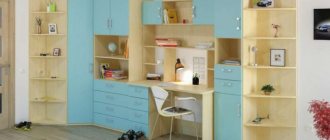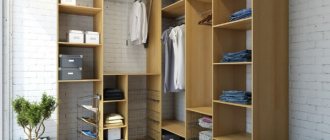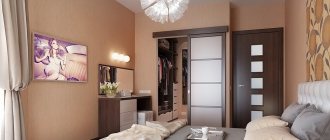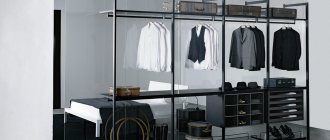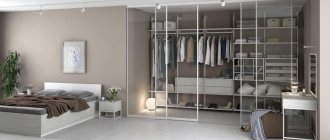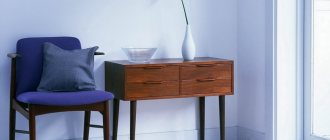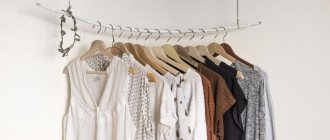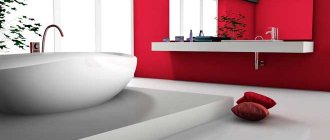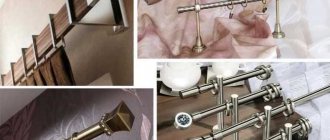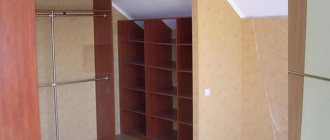When designing modern apartments in new buildings, architects take into account the need for wardrobe space in bedrooms. Most apartments in older buildings do not have a walk-in closet in the bedroom. But what the designers didn’t do, you can do it yourself, regardless of the size of the room. You just need to choose the right place, arrange the furniture correctly, and choose a color scheme.
Pros and cons of a wardrobe in the bedroom
Like any design decision related to the combination of various services and optimization of space, arranging a wardrobe in the bedroom has both advantages and some disadvantages. First, about the pros:
- clothes and shoes are always nearby, there is no need to walk from one room to another;
- a woman can try on outfits, completely abstracted from the world around her. No one distracts her from what she loves, she doesn’t bother anyone. A kind of meditation - just her and her small personal world, where others are not allowed to enter;
- the ability to design the exterior and interior space in the same style as the bedroom;
- there is no need to install additional cabinets, chests of drawers and other furniture that does not always fit into the interior of the room. Everything the housewife needs is in the wardrobe;
- reasonable cost, often lower than that of cabinet furniture;
- even a fairly large but properly planned dressing room can save useful bedroom space compared to furniture.
Among the disadvantages, one can highlight only the limitation in area, depending on the size of the bedroom. But this is an objective reality that must be taken into account. You should proceed from what is available. Naturally, if you have a house with an area of 300 m², it is better to arrange a separate room for clothes and shoes.
But in a two-room apartment, with all the desire and imagination, the most you can count on is a small dressing room, which is best placed in the bedroom. But even in this option, you can find the optimal solution, and it will be more rational than installing a large wardrobe, cabinets and chests of drawers.
Use of the balcony
If the bedroom has a balcony, it can be used as a platform for placing a dressing room. The advantages of this option include:
- the ability to rationally manage the available area of the room;
- the presence of windows that are used as a ventilation system;
- sufficient area to accommodate not only everyday clothes, but also an outer wardrobe.
The disadvantages include:
- the difficulty of rational planning due to the small transverse dimensions of the balcony;
- the appearance of an unpleasant odor from the street, which can permeate things;
- problems when changing clothes and trying on clothes;
- significant temperature fluctuations and high humidity, which negatively affect the service life of clothing with low quality thermal and waterproofing.
When planning to organize a dressing room on the balcony adjacent to the bedroom, it is worth taking into account the specifics of the room. This design is not designed for significant loads, so you should avoid installing a massive cabinet or rack.
Placement principles
Today, the Internet allows you to find a lot of ready-made bedroom designs combined with a dressing room. You can even find an option for a room with a specific standard layout. But not always ready-made solutions will satisfy the owner of the room.
We have to take into account certain nuances and change something. It is better to entrust this task to professionals, although you can try to design a bedroom with a dressing room yourself.
Manufacturing materials
Sliding wardrobes and dressing rooms are used quite intensively, so wear-resistant materials are used for their manufacture:
- Plastic. Durable acrylic, which is resistant to moisture and mechanical stress, is used in the manufacture of facades and other straight or curved parts.
- Tree. Natural wood has a beautiful natural texture. But it is quite heavy and expensive.
- MDF, chipboard. Wood materials are strong and durable, easy to process, and affordable. Combined with glass and metal.
- Glass. This is a durable material that visually expands the space. You can make facades from frosted, glossy or translucent glass.
- Metal. Aluminum and stainless steel are used to make frames, rods, stands and hooks.
Successful wardrobe room designs with system layout and dimensions
For the manufacture of facades (when a built-in dressing room is made by hand or made to order at a factory), chipboard and MDF are used. Impact-resistant glass or plastic is less commonly used.
Plastic
Tree
MDF
Chipboard
Glass
Metal
Zoning, style and design choice
To make the task of drawing up a project easier, you need to decide in what manner it will be completed. Yes, eclecticism is in trend today, but mixing styles requires excellent taste and professional design training, otherwise you may end up with some kind of tacky and even ugly structure.
In addition, it will be easier to work in a clearly defined direction, in accordance with the chosen style. This will not at all limit the author’s imagination, but rather will set a general concept, an understanding of where to move.
Thanks to the technique of separating the recreation area from the dressing room, you can get by with the most minimal fencing, highlighting the location not physically, but logically. To do this, use different colors of walls, lighting, podiums, mirrors, etc.
Before making a choice in favor of any design solution, study the most common types of wardrobes that are built in bedrooms.
Project development
Example drawing of a built-in dressing room
Every dressing room starts on paper. You can hire a specialist or do the work yourself. The designer option is better, but more expensive.
If you decide to act on your own, calculate the dimensions - sufficient for everything to fit. Start with two questions:
- Who is the wardrobe intended for? For a child, man, woman or family?
- What is the cabinet for? The option for jackets in the hallway is different from the compartment in the bedroom.
Organize your shelves into zones to keep men's, women's and children's items separate. Divide your clothes into piles as you would for a real closet. Count the sizes and number of items in each pile. Pay special attention to long items that will hang, such as dresses. They should not lie on the bottom. An example of the calculation result is in Figure No. 1.
Shoe storage system
Consider convenient storage of hats and accessories. Place your shoes separately. See the photo for the original example. Don't forget to provide space for sports equipment, knick-knacks, long-term storage of bulky and out-of-season items.
You may be interested in: Wardrobes for clothes: the best solutions and design projects
“Try on” a built-in wardrobe for your home. You may have to cut or change something.
Incorrectly selected furniture is a big problem that is best avoided. Therefore, when choosing a location and developing a project, you should not rush. Calculate everything and only then start drawings.
Loft
A design made in a similar stylistic solution usually includes a fairly large number of metal elements. Some of them are parts of the frame, including load-bearing ones, but there are also plenty of purely decorative parts.
The main feature of such structures is simplicity and functionality. Racks, rods, and spacers are used in the interior. The style is as close as possible to minimalism, characterized by the absence of partitions, and there are not a large number of separate cabinets and niches.
A small dressing room of this type looks good in bedrooms connected to the bathroom.
The loft is an open type location; here it is especially necessary to emphasize the separation of zones. For these purposes, in addition to mirrors, glass, podiums and visualization, the technique of artificially aging the interior space is used. You can use imitation brick, untreated plaster, whitewashed walls.
Filling
The filling of the wardrobe is carried out according to the recommended principles for filling cabinets and dressing rooms. This means that it would be desirable to divide the internal space into horizontal zones and additional compartments. This, of course, is not an axiom, since each storage project for things is, in fact, individual, but such recommendations will help to optimally use the closet space.
The materials for making its insides are metal, plastic, glass, wood and chipboard. Parts made from chipboard and wood are more versatile and allow you to attach fittings to them or modify them without special skills. Metal elements look more modern, however, they can rarely be modified, only with additional branded attachments or fittings. The photos perfectly demonstrate the separation zones of built-in dressing rooms:
- the first lower zone is reserved for storing shoes and rarely used clothes and things. It has a height of more than 45 centimeters so that high women's boots can be placed there. It is equipped with shelves for shoes and compartments for baskets or boxes. The lower compartment is partially closed with additional doors;
- The middle and main level is where you store frequently used clothing, from underwear to winter coats. For outerwear, a rod is installed in a compartment with a height of more than 1.7 meters. The middle tier is more open than the bottom. It is organized in the form of shelves and drawers. An excellent solution for saving time when choosing the necessary clothes would be to install drawers with transparent or translucent front panels;
- The upper zone determines the storage area for hats and rarely used items. It is recommended not to make it very deep, as this will make it difficult to remove objects from it.
Corner design
The structure is located in a free corner of the room. Doors are hinged or sliding. This design solution is applicable in rooms of any configuration, square, rectangular, or non-standard geometry. The dressing room, located in the bedroom behind the bed, at the head of the room, looks harmonious and is easy to use.
This shape allows you to create a fairly spacious space on an area of 3.5-4 m². Structures located in the corner of the room may differ in exterior and interior content.
Wardrobe ventilation
Ventilation must be provided in the dressing room.
Without ventilation, the room will smell, humidity will increase, and condensation, mildew and mold may even appear on the walls.
If the house is equipped with a natural ventilation system, then the movement of air to ventilate the dressing room is organized according to one of two schemes.
Scheme of ventilation of the dressing room, if the doors of the room open into the hallway, corridor or hall.
The dressing room can be ventilated in the same way as living rooms in the house are ventilated. To bring in fresh air from the street, a supply valve is placed in the window (if there is one) or in the wall.
In the dressing room door, a flow gap is left at the bottom, between the door and the floor, or another opening is made for air passage, for example, a ventilation grill is inserted into the lower part of the door. The hole area is approximately 200 cm2.
Fresh air enters the dressing room through the supply valve from the street, then leaves through the flow gap in the door near the floor to the adjacent room and then goes to the kitchen, into the exhaust duct of the natural ventilation of the house. Look at the diagram of natural ventilation of a private house.
There should be more than two doors between the dressing room and the room where there is a natural ventilation channel.
If the doors of the dressing room open into the living room
, then the air movement for ventilation of the dressing room should be organized in the opposite direction - from the living room, through the flow hole in the door, into the ventilation duct of the dressing room.
In this option, the dressing room is equipped with a natural ventilation channel.
In a house with a forced supply and exhaust ventilation system
In the dressing room, only an exhaust duct is provided. Air enters the dressing room through a hole in the door from the adjacent room, which should have a supply duct.
All ventilation schemes exclude the flow of air from the dressing room into the living rooms.
Where to place a dressing room in the house?
Which dressing room placement option did you choose? Vote! Find out what others have chosen.
Look!
— all polls
Next article:
How to build a house cheaply - inexpensively.
Previous article:
Triangle
The most suitable solution for small rooms. From above, the structure looks like a right triangle, where the adjacent walls of the bedroom are legs, and the outer fence of the dressing room is the hypotenuse.
Cabinets, shelves, niches for shoes and hangers are located on the walls of the room, and a large mirror or bookshelves are mounted on the fence (on the side of the living room).
Varieties
To choose a solution for yourself, let’s figure out what to choose from. There are three main types of dressing rooms:
Wardrobe.
Classic wardrobes are divided into zones for specific types of items. The fittings are fixed on vertical surfaces, which increases the capacity of the cabinet. Doors are hinged or partially sliding.
Closet.
Suitable for oblong rooms - for example, a hallway. The main difference is exclusively sliding doors. The filling is similar to that of clothes.
Partially built-in dressing room.
Inexpensive option without side and rear walls. Chipboard shelves are mounted on the walls of the niches. The remaining part of the built-in wardrobe is assembled from the cabinet structure. If there is a niche more than 1 meter deep, use that. Shelves are located along three walls - there is more capacity, things are accessible and everything is in sight.
There are many classifications of built-in wardrobes: open or closed, triangular or rectangular, modular or prefabricated... Don't limit yourself to specific types, combine. Start from your wallet and the free space in your apartment.
Boiserie
It consists of two elements - shelving, located on both sides of the interior passage, or any other doorway. Sometimes this is the only possible or the most acceptable solution. For example, in old Khrushchev-era apartment buildings, with a walk-through middle room. Suitable for bedrooms with a separate entrance to the bathroom.
They use boiserie panels to decorate the walls. This is more of a design style rather than an original design option. Among the advantages: if desired, the internal elements can be swapped and moved from one part of the structure to another.
Design and color
The design for wardrobe systems is selected taking into account the overall interior design of the apartment or house. The most popular options:
- Classic. The furniture is made of natural wood, which is varnished or stained in different shades (from light red to rich coffee).
- Modern. The designs are made in simple forms, the emphasis is on practicality and functionality. MDF, chipboard, and aluminum are used for production. Colors – white, gray, beige.
- High tech. Minimalist design, which is dominated by materials such as glass, plastic, metal. Solid pastel shades and rich contrasting colors (black, dark brown) are used.
Varieties of modern wardrobe systems, overview of manufacturers
For small rooms it is better to choose light colors of cabinet furniture. This makes it easier to find clothes. Popular colors are light gray, cream, beige, coffee-with-milk shade.
Classic Modern
High tech
Coupe
A wardrobe in the bedroom in the form of a wardrobe is a classic of the genre, an excellent solution for a room of any style and layout. A niche for clothes is separated from the room by sliding mirror doors.
Inside there are rods for hangers, niches, shelves, and cabinets. Usually a width of 1 m is enough, and this is enough to have a new, almost complete room at your disposal. In addition to clothes and shoes, it may also contain other necessary things: an ironing board, a vacuum cleaner, etc.
Below are photos of dressing rooms of various styles located in the bedroom.
Choosing a place for a dressing room
A full-fledged dressing room is most often adjacent to the bedroom or bathroom. Often a storage room or existing corridor is converted into it.
The dimensions of the apartment are not the only criterion for arranging a dressing room. Its location is also influenced by the structure of the home. It is believed that the ideal dressing room is one with two entrances, from the bedroom and from the bathroom. And also one in which there is a window, because in natural light it is clearer how, for example, a blue suit and yellow shoes will look on the street.
Rebuilt closets, voids under the stairs, attics, and even a loggia can serve as places to store clothes.
Actually, there can be several dressing rooms. Men's and women's, for example. Or for seasonal and non-seasonal clothing. Having decided to disperse your wardrobe, you don’t have to look for one large place. And use a few ineffective, empty corners. For example, for seasonal clothing and accessories - a corner closer to the bedroom or living room. For out-of-season items - a distant pantry or space under the stairs.
But what if the apartment is small? In this case, they are content with a compact closet, mezzanine and linen cabinet. This combination is, in fact, also a dressing room.
Interior decoration
Before drawing up a bedroom project with a wardrobe, consider in detail all the nuances of the interior. The main qualities of the interior furnishings are convenience and functionality.
Of course, some changes can be made to the interior later, after the structure has been in use for some time. Experience of use will tell you what needs to be changed: add cabinets, remove unnecessary shelves, etc.
But this can be avoided by carefully considering everything at the preliminary stage. As a visual example, use a closet, chest of drawers, or other furniture that you have used before. This will make it easier to imagine the required number of niches, shelves, and rods for hangers.
Simple recommendations will help you create a convenient ergonomic layout:
- the minimum wardrobe area is 2 m², otherwise its operation will be extremely inconvenient;
- in a compartment, high under the ceiling or in a poorly accessible place, they store things that are used less often than others;
- It is better to keep small toiletries in drawers or boxes;
- At the planning stage, allocate space for storing ties, belts and scarves. For these purposes, you can purchase special accessories;
- It would not be superfluous to equip the structure with a folding ladder to facilitate access to the upper shelves;
- transparent lids of cabinets and drawers make it easier to find the right thing;
- shoes are stored downstairs, preferably in separate boxes.
With the right approach, even in a small area you can create a completely functional and spacious room for clothes and shoes.
Wardrobe without mistakes: what to avoid
Let's look at the main mistakes that are usually made when creating a separate storage room:
- Choosing furniture after the dressing room is built. It’s better to do everything in stages, and the furniture and its location need to be thought through at the design project stage.
- Dark colors are unacceptable, since this is often a small room without windows. Due to the dark color of the walls, the room seems visually even smaller.
- Poor ventilation. A ventilation grille at the bottom of the door or a louvered door will help to avoid the musty smell from things.
- Poor lighting. It is advisable to think about lighting at the beginning of planning, convenient spot lighting, installation of lamps with a motion sensor. Lighting should be sufficient, especially in the fitting area.
- Let's not forget about the little things. Consider places to store small items: belts, gloves, scarves and hats, as well as bag holders.
- Using wallpaper. It is not the best option to stick wallpaper in a dressing room; after installing shelves, drawers, racks, if necessary, changing the wallpaper will cause some difficulties; it is much easier to paint the walls in light colors. Due to poor air circulation and temperature changes, wallpaper can quickly become unusable.
- You should not have a different floor in the dressing room; the same floor looks better; when the door is open, the room looks holistic.
Exterior design
Having chosen a place to place the dressing room and decided what type of structure it will be, you should think about its finishing. The external cladding should look good, match the overall style of the bedroom, be comfortable and durable.
The design of the external design of the dressing room in the bedroom depends on the shape of the structure and the style of the room itself. Some conceptual solutions for the external design of the wardrobe:
- imitation of a secret room;
- separate corner dressing room located in the bedroom;
- a niche separated by a screen, curtain, doors, fence;
- in the form of a large wardrobe (paneled in alder, oak, etc., or natural wood).
These exterior options can be made in various styles. Depending on the preferences of the housewife, the designer realizes his plans in the classical style, minimalism, constructivism, hi-tech, etc.
The interior of the bedroom with a dressing room that has access to the bathroom looks quite original.
Design tips
Among design ideas for small dressing rooms, the most interesting ones are the minimalist options, in which there is nothing superfluous. Snow-white interiors, for example, in the Scandinavian style, are also very popular. If such a design is chosen, the design should be made using light-colored wood and with restrained decor.
When designing a dressing room, the design of the bedroom must be taken into account.
For a spacious bedroom in a modern style, clear or frosted glass in combination with chrome furniture supports is perfect. This solution would also be appropriate when decorating a small dressing room in a high-tech style. It is worth noting that these materials do not visually clutter up the space, and therefore are suitable even for small rooms.
Designs in eco-style deserve special attention. The color palette should be dominated by green, brown, white and their shades. Unpolished wood and natural stone are suitable for finishing.
Light
Lighting the interior space is the most important point in arranging a clothing space. Usually there are no windows here, so you should think about high-quality, correctly selected and installed lamps.
It is desirable that the light be as close to daylight as possible. Otherwise, the chosen image outdoors will not look the same as indoors.
When installing lighting equipment, you need to remember some nuances:
- A simple and effective lighting option is LEDs placed at different levels. They provide a spectrum close to daylight, are economical and do not heat up;
- lighting fixtures installed in cabinets will make it easier to find the things you need;
- soft light, with a correctly selected distance between its sources, will visually increase the interior space;
- in addition to the main large mirror, a smaller, magnifying, illuminated one would not be superfluous;
- Small adjustable lamps mounted on rods under the ceiling look good and are very effective in use. The direction and focus of their beam can be changed.
If you have some skills, you can make a dressing room located in the bedroom with your own hands. First you need to think through all the nuances and competently draw up a project. By working independently, you can not only save money, but also take into account and implement all the customer’s wishes.
Zoning rules
When combining a bedroom and an open dressing room, it is worth visually marking and dividing the interior space. If a niche is chosen to place clothes or doors are installed, you don’t have to think about such a problem. Otherwise, general zoning rules should be used.
This can be done with the help of furniture, partitions, and various interior items that allow you to correctly place accents. A light source or contrasting color may be used to identify certain areas. The mirror partitions look original. But numerous decorative elements should be abandoned. They can become an obstacle when accessing drawers and shelves.
We suggest watching the video to understand this issue even better:
Thus, combining a bedroom and a wardrobe may be a good idea. Especially in confined spaces. The main thing is to take into account all the nuances.
